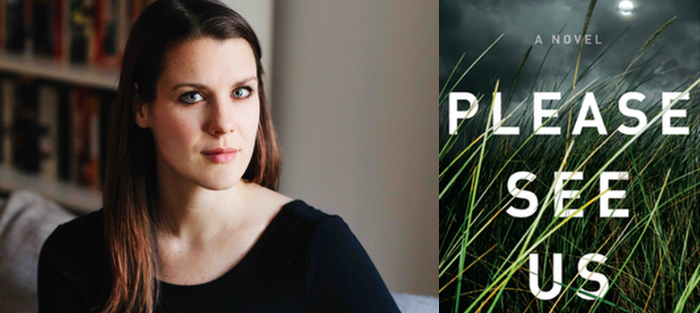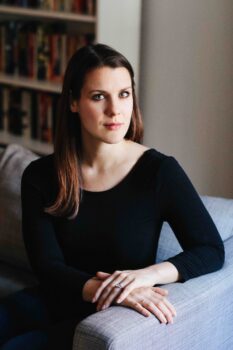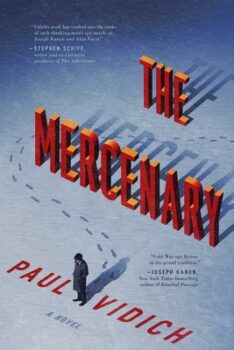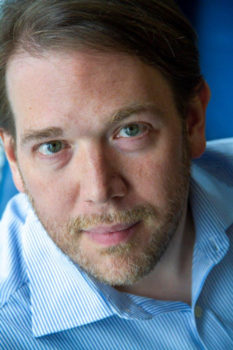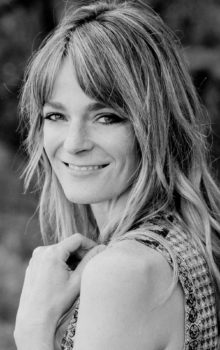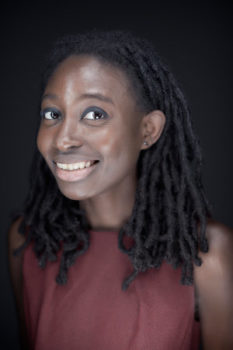Caitlin Mullen drew on her experience growing up in and around Atlantic City, New Jersey, for her debut novel, Please See Us, about a serial killer who terrorizes the beach community over the course of one summer. Inspired by a real-life string of murders, Please See Us places its focus squarely on the victims, not the killer, and instead of a team of cops or detectives working to solve the crime, two young women from different backgrounds team up to try and stop the killer before he strikes again.
Please See Us is narrated from multiple points of view, primarily Clara, a teenage clairvoyant who supports herself reading tarot cards to tourists on the boardwalk, and Lily, an aspiring gallery owner who’s returned to Atlantic City in the aftermath of a personal tragedy. Mullen also includes the voices of the “Jane Does,” the seven women whose bodies have been dumped in a marsh behind a motel where many of them have worked as sex workers. These women have lives and stories, which Mullen amplifies to make them more than just victims. Mullen’s sensitive storytelling creates vivid portraits of women society often overlooks.
The novel interrogates all sorts of violence against women. There’s the casual violence women subject themselves to in order to conform to patriarchal standards of beauty, prostitution, and other forms of debasement, as well as sexual abuse, torture, and, ultimately, murder—all set against the historical backdrop of Atlantic City, a place where glamour and glitz conceal a dark underbelly.
Please See Us was published last March, just as the COVID pandemic took hold in the United States. The New York Times called it “spellbinding” and named it one of the ten best crime novels of 2020. Now in paperback, the novel was recently nominated for an Edgar Allan Poe Award for Best First Novel. Caitlin and I met as fellows at Stony Brook University’s novel fellowship program, BookEnds. She is currently at work on her second novel.
Interview:
Daisy Alpert Florin: Your book came out last spring, just as everything was shutting down. A year later, we’ve adjusted to the realities of pandemic life and many authors have had virtual readings and book tours. I’m wondering how it felt to publish a book during those first weeks. What plans did you have for your launch and how did those change? Was it hard to promote your book while people were experiencing trauma and just generally freaking out?
Caitlin Mullen: My book came out on March 3, and things were just starting to feel off in New York, where I lived at the time. I still had a book launch at WORD in Greenpoint, where I worked while I was finishing Please See Us, and I remember laughing when friends asked if it was okay to hug me. I sort of can’t believe that I still had the opportunity to look around and see friends, family, former colleagues, people from all areas of my life, and it takes on a whole new meaning when I think about how I wouldn’t see any of those people for more than a year and counting.
Like many people, I spent those first few weeks adjusting to our new reality, frantically scrolling through the news and trying to figure out how to stay safe, so for a while I didn’t think much about my book and what the pandemic would mean for sales, book events, publicity. A few weeks later, I would feel more grief about the events I had to cancel and the fact that this experience I had been working toward for so many years had been supplanted by this global catastrophe. But living in New York also gave me perspective. The around-the-clock sirens, the sense of dread, worry for my neighbors and family—that all felt so much bigger, rightfully, than my book.
Please See Us is told from multiple points of view, the main ones being Clara, a teenage clairvoyant, and Lily, a young woman who’s returned to Atlantic City after her career and relationship implode. There are other voices as well, including the seven “Jane Does” whose murders propel the plot. Why did you choose to tell the story this way? Whose voice came first and most easily? Were there any voices you struggled with?
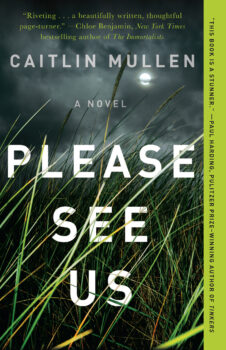 Lily’s voice came first, and in the first draft, the entire story was told from her point of view. Looking back, it makes sense that that was how I’d find my way through the first draft. Lily and I are very different, but in terms of things like class background, education, age, she and I are alike so her voice felt the most accessible to me. But after a while, I started to feel the limits of Lily’s perspective on Atlantic City: she had grown up there but had been gone for years, and she had so much more agency than a lot of the other characters. I was curious what it was like for characters who had fewer choices than she did, what they needed to do to scrape by in this failing resort town.
Lily’s voice came first, and in the first draft, the entire story was told from her point of view. Looking back, it makes sense that that was how I’d find my way through the first draft. Lily and I are very different, but in terms of things like class background, education, age, she and I are alike so her voice felt the most accessible to me. But after a while, I started to feel the limits of Lily’s perspective on Atlantic City: she had grown up there but had been gone for years, and she had so much more agency than a lot of the other characters. I was curious what it was like for characters who had fewer choices than she did, what they needed to do to scrape by in this failing resort town.
After the second or third draft, I took up Clara’s point of view and I struggled with her voice a bit. She’s a teenager who has had to drop out of high school, but she’s also smart and observant and scrappy, so finding her voice without making her sound overly precocious or overlooking the fact that she’s still young and has some blind spots about the world and about herself, took a lot of trial and error.
The Janes came in after I had been working on the book for over a year. I wanted to infuse the book with a sense of hauntedness, and I realized that one way to do that was to let the victims who are at the center of the novel act as a Greek chorus. Later, I added the individual Jane Doe stories because I felt it was important to show them as real women who had hopes and desires and were known to themselves and to the people who loved them as so much more than bodies who had been found in the marsh. These sections were emotionally grueling to write, but oddly enough, they came the quickest for me and required the least amount of editing. It was like they were always meant to have a way to “speak” through the novel.
Atlantic City is almost another character in the book, at times given anthropomorphic qualities: “the whole city is dying around anyone who is left; slowly, though, like a large animal falling to its knees.” The book is also set at a very specific time in the city’s history, after the rise and fall of the casinos that promised to resurrect the city. What was it about the city and this time period that you wanted to capture? How much research did you do and what came from your own experiences?
The book is inspired by a series of real-life crimes that occurred in 2006, when the bodies of four women were found in a desolate stretch of marsh just outside of Atlantic City. I had gone to high school in the area and my family had worked in the casinos for decades by then. I also had my own summer job, like Lily, working at a casino spa, so I definitely drew on those long days working inside this massive, dim casino, where I spent a lot of time walking around and observing people. I had recently graduated from high school when the crime was discovered, and I think at that age it felt like a sort of referendum on what the risks were of being a woman in this world. At that time in my life, my plan was to leave Atlantic City behind, both mentally and physically, but I found myself haunted by that crime and by the fact that these women never got justice, and it was still with me when I started writing fiction seriously in my late twenties.
This is a difficult book that includes scenes of murder and violence, including the sexual abuse of a minor and torture. Was it difficult to write those scenes? How did you access the emotions necessary to describe what some of the characters endure?
Yes, those scenes were always hard to write, and for a while I had the idea for this book in my head but kept pushing it away because I dreaded writing about violence against women. I had also read so many “dead girl” books that prioritized violence and the hunt for a killer over the characters’ humanity. I think the key for me was to make the book, as much as I could, about the cost of that violence. To put a face to it in the form of these characters who populate the novel, to try to make sure that their personhood was clearly defined so the violence never felt titillating or gratuitous. Because as much as I dreaded writing about violence against women, we live in a world where women are subjected to harm of varying degrees, from harassment and verbal abuse to sexual assault and murder, and part of the novel is these women making sense of how to navigate that kind of world for themselves, how to express their agency in light of those very real dangers.
In terms of accessing the emotional aspects of those scenes, I did draw from my own experience. I think a lot of women, myself included, have moments in their life when they look back and see a danger that they’ve narrowly escaped, a moment that feels limned with threat or made their intuition prickle. So in writing those scenes, I drew upon that feeling: the sense of unease when a man followed me on a subway platform late at night, the time a fraternity brother cornered me at a party and told me I had two choices: sleep with him or be forced to leave. Those almosts that could have easily turned out worse had the circumstances been just a little bit different.
The book has an intricate structure, with multiple voices and overlapping timelines. We sometimes see the same scene from two different perspectives. Did this structure arise right away or did it evolve as you were working? How did you keep track of the timelines and perspectives?
The structure arose very gradually, and it wasn’t until the last few months of working on the book that I really understood the kind of overlapping structure I had been working toward. By the later drafts of the book, I was doing a lot of reverse outlining—going through the chapters and noting what I had done, what themes and symbols and even physical objects and places kept coming up, to mine for places where the several POVs of the novel might be knit together thematically or in terms of plot. I did a lot of scribbling on big sheets of butcher paper tacked to the walls, trying to get a bird’s eye view of the narrative, making detailed timelines of where each character is and when. I also separated the book out by chapter and wrote on an index card what the reader learns in each chapter and what they are left wondering about—in some cases, chapters served the exact same functions and I realized they were redundant. Other times I realized I knew something as the writer but was withholding it from the reader, that I needed to give more information at strategic places along the way.
I think, with a long project, there are moments when you use your emotional or subconscious brain in the drafting process, and then later, you get to apply a logical framework to it, and I always like that part of writing: when you get to look at your work as a system of information that reinforces itself, where some components get amplified and others strategically compressed. It’s a different part of the brain and to me, it feels like a reward for all of the days you spent facing down the blank page. All of the answers are somewhere in this world you’ve created, you just need to mine for them.
Lily, one of the main characters, works in a spa and you write about the kinds of services offered to women in these spaces—waxing, dying, bleaching—as almost another kind of violence. A woman who comes into the spa is described as “constantly negotiating with her body, thinking of it as something to be punished or tamed.” In a book about violence against women, why was it important for you to have this setting? What do you consider the connection between “spa violence” and other kinds of violence?
Thank you for picking up on that! It was important to me that the book touch on a variety of the ways our culture reinforces ideas of women’s value. We live in a world that is characterized by patriarchal standards about what it means to be a woman, to act like a woman, to have power as a woman. Usually it involves being white, thin, conventionally attractive, sexy but not too available, submissive, to not have body hair or appetites or needs—that’s how women are taught to gain notice or get a foothold in the world. To be smaller and to standardize themselves, to be tidy and quiet. Like physical violence, this is another way of erasing women’s humanity, this insistence on being one way, on adhering to these rules about how to look and how to relate to your own body.
This is also a book about art. Lily is an aspiring gallery owner and there is a long section describing a sort of performance art experiment gone wrong. In Atlantic City, in addition to hunting for the killer, Lily is also trying to identify the anonymous artist who has painted a series of paintings depicting the city and its inhabitants. In a book about murder, why was it important to you to include questions about the value of art and who it is meant for?
I think I was most interested in the kinds of complicated questions that arise around art and subject and how art can be its own kind of violence. In some cases, a portrait is an homage to a person or place, a way to honor them. Paying that kind of supreme attention to a thing or person is its own unique form of love. But other times, art is a distortion or a kind of theft. The performance art piece you mention is something that is executed cynically, with the aim of making a splash and without regard to who gets hurt along the way—in this case, it happens to be Lily, and being made into the subject of a piece of art makes her realize she’s lost her way. When she finds the anonymous paintings, Lily appreciates their frankness and lack of pretense. In this case, I wanted to use art as a way to track what characters care about and why, how what they see relates to their values.
As a writer, the paintings were also a way for me to include snippets of Atlantic City history in the book that maybe wouldn’t have a place otherwise. The novel depicts Atlantic City during the post-recession years, run down and faltering. But my goal in the novel wasn’t to demean Atlantic City—rather the opposite. I think it is a fascinating place surrounded by immense natural beauty with an incredibly interesting history and I wanted to honor that beauty and history as much as I could.
This book also subverts genre in interesting ways. Please See Us is not your typical murder mystery—there are no detectives or cops working the case and while there’s a climax, it doesn’t involve cops busting in and leading a perp away in handcuffs. In fact, it doesn’t seem like the cops are involved at all. Was this a conscious choice on your part? Did you feel pressure to have the novel conform to traditional mystery standards?
Sometimes I think the book sits a little uneasily in the mystery/thriller category, where the story often comes to a neat conclusion and justice is meted out to the “bad guys” by a heroic detective or cop—though in the unjust world we live in, I certainly understand the appeal of that kind of clean and redemptive narrative arc. I felt more comfortable when I started to think of the novel as an “inverse thriller,” one that was less concerned with catching the person who committed the crime and more concerned with the personhood of the victims. When a novel is structured around finding a killer it, by default, requires the protagonist to get inside that killer’s head. The killer gets to take over the story—and part of the thrill of committing these kinds of crimes is about controlling the narrative. I didn’t want to cede more of that territory to someone whose point of view I wasn’t interested in—it doesn’t make you fascinating to be violent toward women. The women themselves though, these people who were just trying to make the right choice in order to survive when everything feels like the wrong choice…that was an experience that was so much more intriguing to me.
Can you tell us anything about what you’re working on now?
I’m working on a second novel, though there have been a lot of ups and downs and interruptions this year. I gave birth to my daughter five months before Please See Us was published, and becoming a mother shifted my interests in terms of what I wanted to work on. I’m in the process of expanding a short story I wrote in grad school into a book, in which a mother leaves on the first crewed mission to Mars and her daughter has to reckon with the turmoil of being a young woman on Earth and all that that entails. I think it will, strangely enough, have a lot in common with Please See Us, in terms of its exploration of womanhood and power. Becoming a parent around the same time as publishing a book (not to mention making it through a pandemic with no outside childcare) made me think a lot about ambition as it relates to parenthood, the risks and rewards inherent in pursuing your dreams while someone else is dependent on you.

